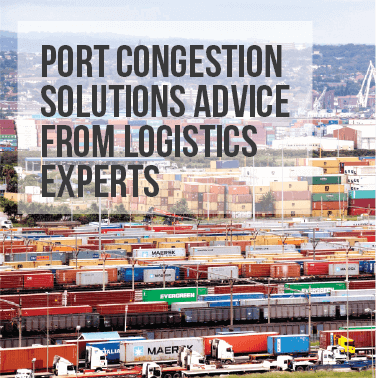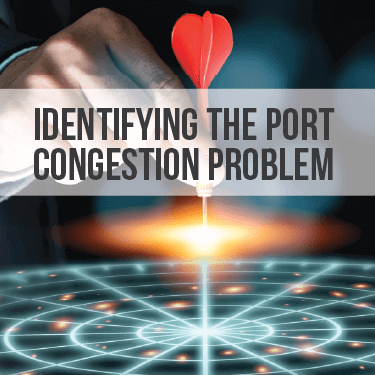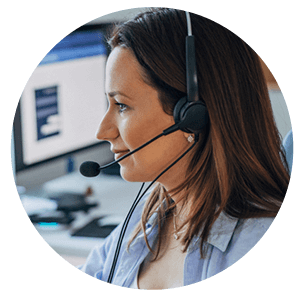
Congestion at ports and shipping delays continues to be a major problem for the global supply chain, even in 2024.
Possible port congestion solutions include:
In addition to these alternatives, an experienced 3PL (third-party logistics company) can identify and recommend other possible solutions custom tailored to your business.
Results of these workarounds for port delays may vary. However, our industry experts agree on one thing: The current landscape is in need of help and therefore requires inventive problem-solving.
Our article below explores the port congestion issues that have troubled the U.S. We also examine some of the most proven solutions alongside advice and insights from logistics experts within our company and from our exclusive partners.

Are ports still congested? The short answer is: Yes. Lack of workers, limited space, and a persistent shipping container shortage are just a few of the ongoing challenges.
So with these problems surrounding this facet of importing, businesses and 3PL companies are looking for port congestion solutions to alleviate these issues to some degree. But before solutions can be offered up for this issue, the problems causing the congestion must be fully known and understood.
The congestion problem doesn’t just stem from one specific, easily fixable issue. In fact, several different aspects of the overall supply chain are all experiencing issues at once to cause massive port delays. Unfortunately, there isn’t one definitive thing that can be pointed to and rectified immediately.
The biggest problem is one of simple real estate. Right now, there are a variety of things helping form a domino effect to create the back-up at ports in the form of vessels waiting:
This is happening globally, so there are few, if any, places that are unaffected by it. The issue of cargo ships sitting just off the coast could have other unintended effects, such as additional transportation pollution.
Robert Bowman, President of R+L Global Logistics, based in Ocala, Florida, doesn’t necessarily see these congestion problems easing up overnight.
“It’s kind of the perfect storm,” Bowman said. “Imports are up; chassises (a special truck that can transport ocean shipping containers) and the real estate at the port are down.
“We’re going to work our way out of it but it’s going to be a 2- or 3-year deal until it’s back to normal.”
When someone like Bowman doesn’t see an end to these issues anytime soon, it seems clear that some creative problem solving will be necessary to overcome these issues.

Again, it’s worth restating a final time: there’s no magic bullet to cure the current crisis at ports. For many years, the U.S. has imported more than it’s exported, but the present situation is even more skewed.
Still, for importers and even the logistics companies helping serve them, there are some possibilities to explore to help lessen the pressure of port delays.
A few of these might even venture into “let’s try it and see what happens” territory. But being faced with an unprecedented issue obviously needs ideas that are a departure from the usual line of thinking.

Ask Our Logistics Experts.
Our Licensed Customs Brokers can provide custom tailored solutions and ease your import concerns.
West coast port congestion has long been the biggest issue when it comes to U.S shipping delays. The ports of Los Angeles and Long Beach, in particular, have seen as many as 70 ships docked off the coast awaiting port access at the height of the congestion problem.
Finding alternate ports can be a fairly simple solution to this problem. Not every importer possesses the vast resources to be able to do this, but if you partner with a 3PL, this is definitely something worth looking into.
On the west coast in North America, alternate ports of entry to consider include:
There are also American ports in the Gulf of Mexico in Houston, Texas; New Orleans, Louisiana; Gulfport, Mississippi; and Mobile, Alabama. These ports might require transloading services, or access to the Panama Canal in order to reach the gulf.
On the east coast, the ports of Miami, Florida, New York and New Jersey often have their own congestion issues. However, there are many smaller ports along this side of the U.S. that can be used. These ports are:
It’s important to note that some of the above ports are only able to accommodate smaller cargo ships. Thankfully, though, logistics companies are becoming more familiar with some of these less commonly utilized ports. In many cases, this is out of necessity, but also because they can be leveraged to help dissipate some of these delays and avoid west coast port congestion.
“The mid-ports — Mobile, Jacksonville — can play into that,” Bowman said. “[R+L Global Logistics is] centered around those mid-sized ports, so we can offer this as a solution.
Thankfully, you don’t have to become an expert in all of the available ports of entry. You simply need to partner with an experienced and resourceful logistics partner. The right partner will have the knowledge to find the best solution for your situation.
“We’re working with the steamship lines and overseas partners and asking for these different routes,” he added.
One of the most frustrating aspects of the current port delays is there are many shipping containers fully packed and ready for the content inside of them to be unloaded and dispersed throughout the country. Yet, due to the congestion problems, the freight inside these containers remains stuck.
A way to try to avoid this fate is by spreading or staggering the shipping containers across multiple vessels. Of course, if you attempt this, you won’t want to target multiple ports with expected long port delays or overall congestion.
The theory behind this possible solution is to increase your chances of getting freight into the port and then getting it processed once it reaches land. This is a scenario in which a customs broker can assist you. Customs brokers are in the business of knowing the challenges at the ports and how to overcome them.
Our team of Licensed Customs Brokers are certified to clear imports for clients across all U.S. ports of entry. This ability provides us with unique access and knowledge and allows us to quickly react to ongoing situations.
Of course, it’s hard to predict the future, but businesses now have to be flexible and able to do some guesswork when determining when they’ll need to order their products overseas. The same goes for booking freight capacity — the more time a 3PL has to secure your freight’s transport, the more likely it is that they’ll be able to do so.
Businesses can actually receive help with this if they feel uncomfortable or unable to do so. This is a direct benefit that 3PLs can provide, since forecasting is a crucial piece of their operations.
“The biggest thing is in their supply chains. They really need to look at their lead times and their forecasts,” Bowman said, “and partnering with a logistics company that does this on a day-to-day basis [is good] so you’re not going to be shocked about this.”
This means putting in orders as soon as possible for non-perishable commodities. Better planning for those that do have a shelf life is also crucial. This ensures that there’s plenty of time for orders to be fulfilled and get where they need to go without that shelf life expiring.
Similar to using alternate ports, transloading cargo between multiple modes of transport provides more ways for freight to be moved.
Instead of the standard ocean to truck transportation that so many shippers rely on, explore options for rail or air transport. You could even explore options like using multiple distribution centers or hubs that trucks can use to consolidate before arriving at its final destination.
Done correctly, intermodal transport can actually decrease shipping delays and help clear up congested ports.
As much as the step-by-step mechanics can be looked at and tweaked, sometimes it helps to be able to sit down and receive personalized guidance from a person or company that has the answers.
This is why an import consultation can be a great asset to lean on. Logistics companies have experts in this field who know how to pull off any kind of freight movement. Better yet, you can plan in real time with this person to see what works for your individual commodities and the optimal way to attack the port congestion issue.
USA Customs Clearance, powered by AFC International, is one such logistics partner that can offer this service. Whether it’s a one-time session or scheduled for recurring monthly meetings, USA Customs Clearance can accommodate this. Some of the potential topics of discussion could include:
Paul Gentzke, retired-Vice President of AFC International, LLC and a licensed Customs Broker, notes the benefits of these 1-on-1 consultations.
“Our clients appreciate the 1-on-1 nature of our consulting sessions,” Gentzke said. “Most of our clients have struggled to find the right information when it comes to importing into the U.S. After we consult with them, they’re relieved to finally have a clear path forward for bringing in their products.”
In reality, it is your time with the import consultant, so you can ask anything about customs you’d like. It can really be a great value and save you thousands of dollars with enlightened planning, not getting hit with large fines from U.S. Customs and Border Protection (CBP), or even high demurrage fees.
No matter which way you slice it, the cost of purchasing consulting can prevent you from being shocked later with bigger costs because of poor import compliance. The value and benefit of consulting with a logistics and customs expert is well worth the cost.

Ask Our Logistics Experts.
Our Licensed Customs Brokers can provide custom tailored solutions and ease your import concerns.

One interesting idea Bowman brought up during his interview was changes the terminal operators themselves could make to help alleviate some of this overwhelming pressure on the U.S. supply chain.
Chief among those ideas was this — some of the busier ports switching to a 24/7 schedule.
“To help port congestion, a lot of ports need to go to a 24/7 model,” Bowman said. “A lot of ports aren’t operating on that.
“With less congestion in the middle of the night in Los Angeles (for instance), goods can move faster and that would help alleviate some of this.”
When congestion at the ports persists, the issue then compounds to trucks and truck drivers, which are both currently in short supply.
But it’s not just the ports or truckers alone. Warehouses must also extend their availability. This will enable them to receive freight at any time which will go a long way in resolving these issues at a quicker pace.
Even 3PL companies must rethink the way transportation occurs. Bowman also floated the idea of looking at the way drayage should work in the current economic climate.
Drayage is generally a short trip — like from the port to a distribution center, for instance — with the intent of linking the freight to its final transport vehicle to be delivered. This can be a trip that takes several hundred miles and can tie a single driver up for an entire day.
“It’s looking at the distance and maybe using a transload process,” Bowman said. “And looking at partnerships with carriers and eliminating the distance at the dray.
“Instead of doing one port-to-door delivery for 400 miles, we can do several shorter ones.”
These importation problems require port congestion solutions. So the next time you plan on importing into the U.S., turn to USA Customs Clearance to get a leg up to combat these port delays.
A licensed customs broker can help you navigate these uncharted waters in a multitude of ways. One is by helping anyone importing goods to properly complete and file the necessary paperwork to begin the process. From there, we can clear your commodities through the ports and also help direct them on their way to their final destination.
Taking it a step further, USA Customs Clearance offers individual import consulting sessions with a licensed customs broker. In these sessions, you can learn the ins and outs of everything about customs and also ask commodity-specific questions without interruptions. You can get suggested solutions to your unique challenges and this can take place as single or monthly meetings — whatever your preference.
Gentzke said, “In our Consulting sessions, we’ve helped hundreds of importers get up and running with their import program, review their tariff classification and rate of duty, obtain duty refunds from Customs and solve a myriad of other compliance related issues.”
Nearly any import will require the purchase of a customs bond and that’s yet another area where USA Customs Clearance can step in and assist you with. It doesn’t matter what commodity needs to be covered, our continuous customs bond ensures your import is properly covered and secure for 12 months.
Ready to get help? Schedule your 1-on-1 consultation with our team today. Have questions before you get started? Contact our experts at 855-912-0406 and we’ll be happy to assist you and find the right solution for your needs.

Ask Our Logistics Experts.
Our Licensed Customs Brokers can provide custom tailored solutions and ease your import concerns.
 Copy URL to Clipboard
Copy URL to Clipboard

Google is changing how it surfaces content. Prioritize our high-quality guides and industry-leading coverage in search results by setting usacustomsclearance.com as a preferred source.
Add your first comment to this post